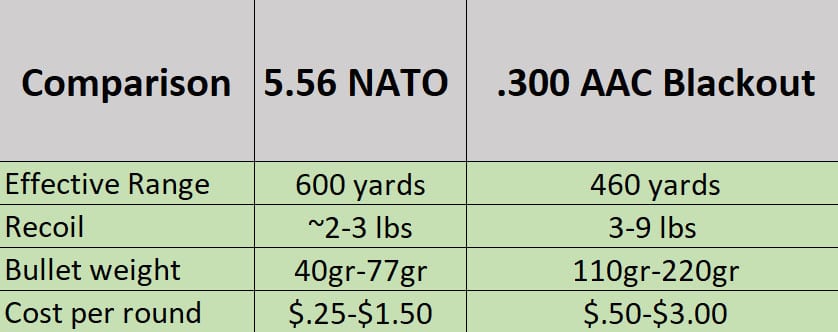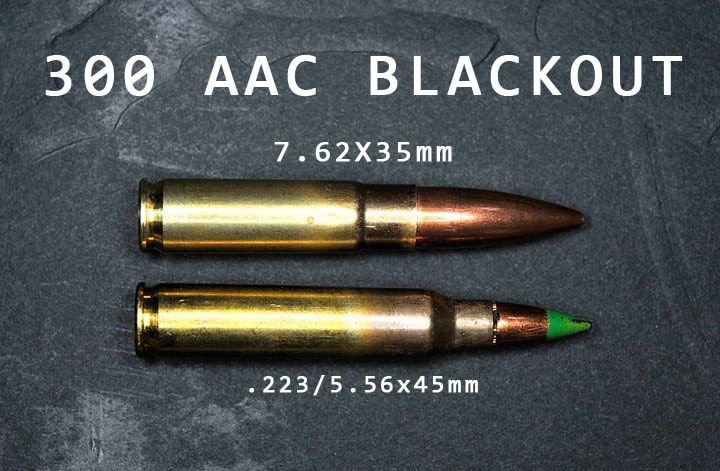Few cartridges have received the love (and the hate) as the 300 AAC Blackout. In order to truly appreciate this caliber, it is important to understand what it is, where it came from, and just what it can do. From its power to its uses, the 300 Blackout might surprise you!
Why 300 AAC Blackout for AR-15?
It is no secret that the AR-15 is the most popular firearm in the United States. This is largely in part due to its incredible versatility and ability to be customized. Throw in the fact that it has very mild recoil and is very easy to use and operate, and it’s clear why this is “America’s rifle”.

But the 5.56mm/.223 round that the AR-15 shoots does have its shortcomings, such as being a very small and light round. To solve this, the 300 BLK gives an AR-15 the ability to shoot a larger, heavier round simply by swapping out the upper receiver.
The AR-15 is the perfect platform to do this with, as you do not need to make any changes to the lower receiver. The versatility of this platform made it the perfect candidate for the 300 BLK.
Even the exact same magazines can be used, just make sure you are using the correct ammunition for the type of upper you are shooting!
History of the 300 AAC Blackout
Designed by Advanced Armament Company (AAC), this round was meant to fill a need for a round that provides better performance than that of the standard high-energy rounds, and better subsonic performance than the standard 9mm rounds.
AAC specifically designed the 300 BLK for the M4 platform in cooperation with Remington. It was made to tackle the negative drawbacks that other calibers have had when used in the M4 platform, as other gun manufacturers had tried various 30 caliber rounds in the platform with mixed success.
The 300 Blackout was designed to implement the following:
- Same capacity in standard .223 magazines
- Same bolt as .223/5.56 NATO
- Cases created from .223/5.56 NATO round
300 Blackout vs 5.56mm/.223
Both the 5.56mm and the 300 Blackout are great medium-range rifle rounds that excel at things like home defense, target shooting, and even hunting.
They both do have some noticeable differences though, and one might be better than the other depending on who is using it.

For starters, the 5.56mm and .223 are both relatively inexpensive, especially when compared to the 300 BLK. They also have less recoil, and the ammo weighs much less. Bullet speed will be much faster, which could be a good or a bad thing depending on your needs. Lets go further.
Maximum Range and Performance
The 5.56mm will shoot much flatter than the 300 BLK, but the latter does have a larger variety of projectiles to choose from thanks to its 30 caliber bore.
This, combined with its ability to shoot heavier bullets, have made the 300 BLK a more popular hunting choice for large game.

The 300 BLK also has a much easier time handling both subsonic and supersonic ammo, especially without any additional ammunition. This gives it the edge with short barrels and suppressors, which makes sense as it was partly designed for these things.
Terminal Ballistics
Terminal ballistics are basically how a round performs once it finally hits its target. Its size, speed, design, density, and weight all come into play with its terminal ballistics, and this all effects what kind of power and wound channel it will have.
While the average person might look at the two rounds and choose the 300 BLK simply because it has a larger bullet and bigger diameter, this does not necessarily mean it has better terminal ballistics.
With the correct loads and modern bullet designs, the 5.56mm can close the gap between smaller rifle bores and big bore calibers.
Bullet Performance
The 5.56mm round was also designed to flip, tumble, and break up upon impact, causing fragmentation and deformation. When encountering a target, this causes much more damage than if it were to just travel straight through.
There are many stories of the 5.56mm/223 “punching holes” in targets but this is commonly traced to using a steel core round that was designed for piercing body armor. Any modern or premium bullets will not have this effect and will perform as they should.
No matter which caliber you choose, there is plenty of variety of bullets and loads to match to your intended use. Even more options become available if you reload your own ammunition as well.
Subsonic vs Supersonic Ammo
Many people are familiar with these two types of ammo, but supersonic ammunition is ammo that will travel faster than 1125 feet per second, while subsonic will travel slower than that.
This exact number is approximately the speed of sound at sea level, so when a bullet travels faster than the speed of sound it will create a sonic boom.
A sonic boom is partly what makes a gunshot so loud, and the other part is from the explosion of gunpowder. Adding a suppressor to the mix is used to control the loud expanding gasses exiting the muzzle, making a firearm quieter.
In order to have the quietest shot possible, you must use a proper suppressor coupled with subsonic ammo.
The 300 BLK excels at both of these things, and the cartridge was primarily designed for subsonic rounds to be fired.
Comparison Summary
- Both .300 AAC Blackout and 5.56 NATO are an intermediate class rifle cartridge great for hunting, target shooting, plinking, and home defense.
- The 5.56 NATO is also safer for home-defense because the rounds tend to tumble a break apart quickly after impact
- The .300 AAC Blackout is approximately twice the cost of a .223/5.56 NATO round
- The 5.56 NATO also shoots flatter with a little less recoil
- The .300 AAC Blackout, due to its .30 caliber bore, has a wider range of projectile choices, burns its full potential in a 9″ barrel, and is typically a better choice for hunting especially anything within 100 yards
- It also runs smoothly both super and subsonic ammunition without modification.
- The .300 AAC Blackout really shines with the use of a suppressor
Final Thoughts
So is the .300 Blackout the round for you?
As you can see, there are many benefits to having one, especially if you already own an AR-15 (or a few). All you need to do is get an additional upper receiver with some ammunition and you can easily take full advantage of both calibers with the same platform!
Caligunner Copyright © 2024.


